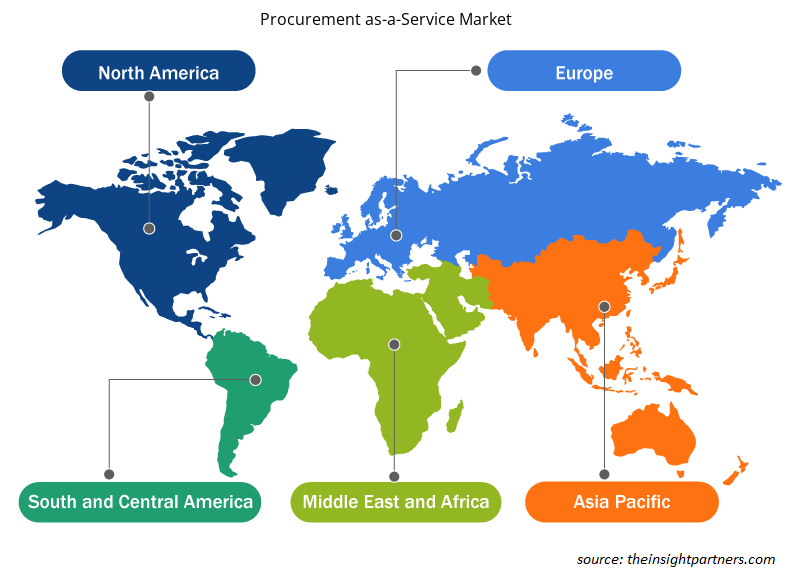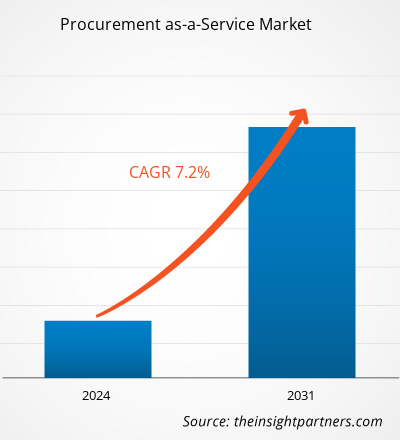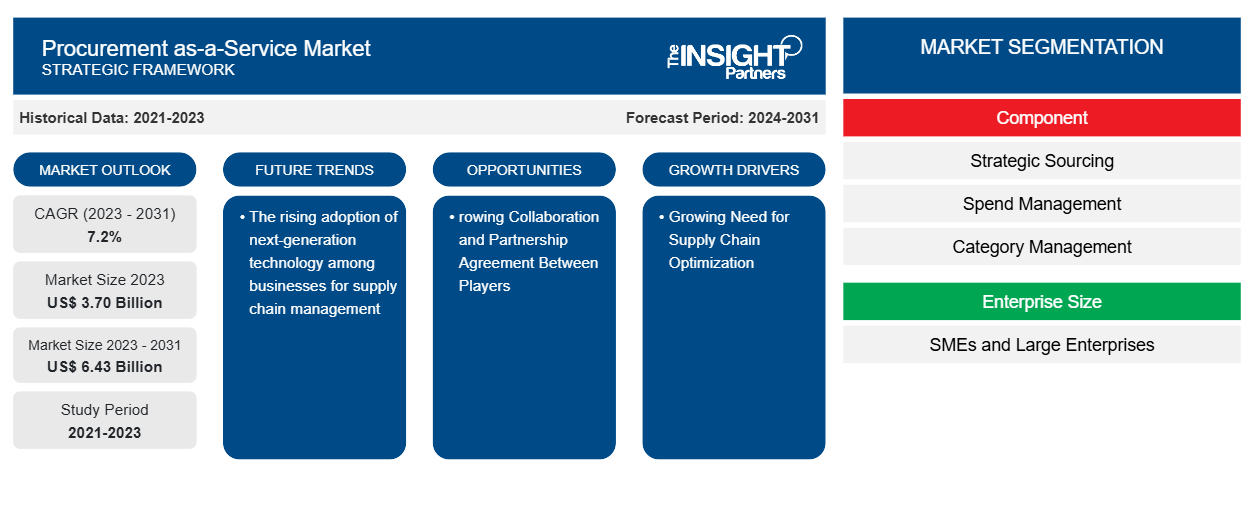Procurement as-a-Service 시장 규모는 2023년 37억 달러에서 2031년 64억 3천만 달러로 성장할 것으로 예상됩니다. 이 시장은 2023~2031년에 7.2%의 CAGR을 기록할 것으로 예상됩니다. 공급망 관리를 위한 기업에서 차세대 기술을 점점 더 많이 도입하는 것은 Procurement as-a-Service 시장의 주요 추세로 남을 가능성이 높습니다.
구매 서비스 시장 분석
조달 서비스 시장은 공급망 최적화에 대한 필요성이 커지고 전 세계적으로 수입 및 수출 활동이 늘어나면서 빠른 속도로 성장하고 있습니다. 이 시장은 워크플로 자동화를 위한 디지털화를 촉진하려는 정부 이니셔티브에 힘입어 꾸준히 확장되고 있습니다. 게다가, 플레이어 간의 협업 및 파트너십 계약이 확대되면서 시장 성장에 수익성 있는 기회가 제공되고 있습니다.
구매 서비스 시장 개요
서비스로서의 조달(PaaS)은 조직의 조달 요구 사항을 충족하기 위해 리소스(사람, 도구, 지식)를 결합하는 아웃소싱 조달 모델입니다. 오늘날 많은 조직은 초기 문의에서 최종 송장까지 전체 구매 프로세스를 관리하기 위해 컴퓨터를 사용합니다. 또한, 거래 자동화를 용이하게 하기 위해 디지털 조달에 파괴적 기술을 사용합니다. 나아가 전략적 소싱 및 공급업체 관리와 같은 예측적이고 사전 예방적 운영을 가능하게 하여 조직의 운영 비용을 낮춥니다. 규정 준수 및 계약을 처리하여 조달 운영을 간소화해야 하는 비즈니스 요구가 증가함에 따라 시장이 주도되고 있습니다.
귀하의 요구 사항에 맞게 이 보고서를 사용자 정의하세요
이 보고서의 일부 또는 국가 수준 분석, Excel 데이터 팩을 포함하여 모든 보고서에 대한 사용자 정의를 무료로 받을 수 있으며 신생 기업 및 대학을 위한 훌륭한 혜택과 할인 혜택을 이용할 수 있습니다.
- 이 보고서의 주요 시장 동향을 알아보세요.이 무료 샘플에는 시장 동향부터 추정 및 예측까지 다양한 데이터 분석이 포함됩니다.
서비스로서의 조달 시장 동인 및 기회
공급망 최적화에 대한 증가하는 요구
공급망 관리자는 공급망의 전반적인 운영을 모니터링하기 위해 조달 관리 서비스를 적극 채택합니다. 이러한 서비스를 통해 공급망 관리자는 공급망의 잠재적 문제를 상당히 예상하고 그에 따라 리소스를 재할당할 수 있습니다. 더욱이, 서비스로서의 조달은 비즈니스 프로세스의 효율성을 개선하는 데 사용되는 신뢰할 수 있는 데이터 기반 솔루션을 생성할 수 있습니다. 조달 관리 소프트웨어는 사용자가 정상 상태 운영을 관리하고 교차 기능적 가시성을 높이는 데 도움이 되는 예외 기반 프로세스 관리 시스템을 제공합니다. 그 결과, 소비자는 공급망의 투명성, 주문 공개 및 배송 데이터를 유지하기 위해 조달 관리 소프트웨어에 점점 더 많이 투자하고 있습니다.
플레이어 간 협력 및 파트너십 계약 확대 – 서비스로서의 조달 시장에서의 기회
기술 발전과 시장 참여자들 사이에서 클라우드 컴퓨팅 , AI, 데이터 분석, ML 기술에 대한 수요 증가로 서비스 제공이 향상되면서 시장에서 기회가 창출되고 있습니다. 게다가 소비자들 사이에서 기술적으로 진보된 서비스에 대한 수요가 증가하면서 시장 참여자들은 혁신적인 솔루션을 개발하거나 기존 포트폴리오에 기능을 추가하게 되었습니다. 예를 들어, 2022년 11월, Corbus, LLC는 GIS와 공급망 조달 파트너십 계약을 체결하여 고유한 솔루션을 개발했습니다. 이 파트너십은 GIS가 유럽, 라틴 아메리카, 북미, 아시아, 중동 및 아프리카 전역의 고객에게 인프라와 리소스를 제공할 수 있도록 지원합니다.
구매 서비스 시장 보고서 세분화 분석
구매 서비스 시장 분석에서 도출되는 주요 세그먼트는 구성 요소, 기업 규모, 최종 사용자입니다.
- 구성 요소를 기준으로 시장은 전략적 소싱, 지출 관리, 범주 관리, 프로세스 관리, 계약 관리 및 거래 관리로 세분화됩니다. 지출 관리 부문은 2023년에 더 큰 시장 점유율을 차지했습니다.
- 기업 규모 측면에서 시장은 중소기업과 대기업으로 나뉩니다. 대기업 부문은 2023년에 더 큰 시장 점유율을 차지했습니다.
- 최종 사용자를 기준으로 시장은 IT 및 통신, 소비재 및 소매, 제조, 에너지 및 유틸리티, 의료, 호텔 및 관광, 기타로 세분화됩니다. 제조 부문은 2023년에 시장에서 가장 큰 점유율을 차지했습니다.
지역별 Procurement as-a-Service 시장 점유율 분석
조달 서비스 시장 보고서의 지리적 범위는 주로 북미, 아시아 태평양, 유럽, 중동 및 아프리카, 남미/남중미의 5개 지역으로 나뉩니다.
수익 측면에서 북미는 공급망을 강화하기 위한 AI, 블록체인 및 기타 기술의 기술 발전과 통합으로 인해 가장 큰 조달 서비스 시장 점유율을 차지했습니다. 기업의 디지털화를 촉진하기 위한 상당한 정부 투자가 이 지역의 시장을 활성화하고 있습니다. 디지털화가 확대됨에 따라 시장 참여자는 조달 프로세스를 간소화하기 위해 디지털 기술을 채택하게 되었고, 이는 북미 시장의 성장을 촉진하고 있습니다.
구매 서비스 시장 지역 통찰력
Insight Partners의 분석가들은 예측 기간 동안 Procurement as-a-Service 시장에 영향을 미치는 지역적 추세와 요인을 철저히 설명했습니다. 이 섹션에서는 북미, 유럽, 아시아 태평양, 중동 및 아프리카, 남미 및 중미의 Procurement as-a-Service 시장 세그먼트와 지리적 분포도 논의합니다.

- Procurement as-a-Service 시장에 대한 지역별 데이터 얻기
구매 서비스 시장 보고서 범위
| 보고서 속성 | 세부 |
|---|---|
| 2023년 시장 규모 | 37억 달러 |
| 2031년까지 시장 규모 | 64억 3천만 달러 |
| 글로벌 CAGR (2023-2031) | 7.2% |
| 역사적 데이터 | 2021-2023 |
| 예측 기간 | 2024-2031 |
| 다루는 세그먼트 | 구성 요소별로
|
| 포함된 지역 및 국가 | 북아메리카
|
| 시장 선도 기업 및 주요 회사 프로필 |
|
Procurement as-a-Service 시장 참여자 밀도: 비즈니스 역학에 미치는 영향 이해
Procurement as-a-Service 시장은 소비자 선호도의 변화, 기술 발전, 제품의 이점에 대한 인식 증가와 같은 요인으로 인해 최종 사용자 수요가 증가함에 따라 빠르게 성장하고 있습니다. 수요가 증가함에 따라 기업은 제품을 확장하고, 소비자의 요구를 충족하기 위해 혁신하고, 새로운 트렌드를 활용하여 시장 성장을 더욱 촉진하고 있습니다.
시장 참여자 밀도는 특정 시장이나 산업 내에서 운영되는 회사나 기업의 분포를 말합니다. 주어진 시장 공간에 얼마나 많은 경쟁자(시장 참여자)가 존재하는지 그 규모나 총 시장 가치에 비해 나타냅니다.
구매 서비스 시장에서 운영되는 주요 회사는 다음과 같습니다.
- 액센추어
- 캡제미니 SE
- 코르버스
- 유한책임회사
- 젠팩트 유한회사
- GEEP는
면책 조항 : 위에 나열된 회사는 어떤 특별한 순서에 따라 순위가 매겨지지 않았습니다.

- 구매 서비스 시장 주요 업체 개요를 알아보세요
서비스로서의 조달 시장 뉴스 및 최근 개발
구매 서비스 시장은 1차 및 2차 조사 이후의 질적, 양적 데이터를 수집하여 평가합니다. 여기에는 중요한 기업 간행물, 협회 데이터 및 데이터베이스가 포함됩니다. 다음은 구매 서비스 시장과 전략의 개발 목록입니다.
- 2024년 2월, Vodafone Group Plc와 International Machine Business Corp는 업계 수준에서 협력하여 GSMA Post-Quantum Telco Network Taskforce를 이끌고, 특히 포스트 양자 암호화가 글로벌 통신 공급망 전반에 채택됨에 따라 파트너와 고객이 양자 안전 여정을 지원하게 됩니다. (출처: Vodafone Group Plc, 보도자료, 2024)
Procurement as-a-Service 시장 보고서 범위 및 제공물
"Procurement as-a-Service 시장 규모 및 예측(2021-2031)" 보고서는 아래 영역을 포괄하는 시장에 대한 자세한 분석을 제공합니다.
- 범위에 포함된 모든 주요 시장 세그먼트에 대한 글로벌, 지역 및 국가 수준의 시장 규모 및 예측
- 동인, 제약 및 주요 기회와 같은 시장 역학
- 주요 미래 트렌드
- 자세한 PEST/포터의 5가지 힘과 SWOT 분석
- 주요 시장 동향, 주요 업체, 규정 및 최근 시장 동향을 포괄하는 글로벌 및 지역 시장 분석
- 시장 집중도, 히트맵 분석, 유명 기업 및 최근 개발 사항을 포함하는 산업 환경 및 경쟁 분석
- 자세한 회사 프로필
- 과거 분석(2년), 기준 연도, CAGR을 포함한 예측(7년)
- PEST 및 SWOT 분석
- 시장 규모 가치/거래량 - 글로벌, 지역, 국가
- 산업 및 경쟁 환경
- Excel 데이터세트
최근 보고서
사용 후기
구매 이유
- 정보에 기반한 의사 결정
- 시장 역학 이해
- 경쟁 분석
- 고객 인사이트
- 시장 예측
- 위험 완화
- 전략 기획
- 투자 타당성 분석
- 신흥 시장 파악
- 마케팅 전략 강화
- 운영 효율성 향상
- 규제 동향에 발맞춰 대응





















 무료 샘플 받기 - 서비스로서의 조달 시장
무료 샘플 받기 - 서비스로서의 조달 시장